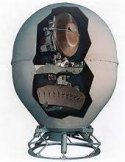SPG-62 is an exception in the history of CW emitters and radars, and you cannot use this as the general example. Monostatic CW radar applications are as common as the parking radar on your car, to the radar guns police use to nail your car's speed on the highway. Another is their use as altimeters such as on helicopters.
Plus I am not talking about the SM-2. I am talking about the HQ-16, and the history back to the Buk and other Soviet SAMs. SPG-62 cannot be considered a radar as being one way.
Some FMCW radars which are monostatic. These radars track the targets on their own and illuminate them. The Square Pair radar used by the Soviets.
View attachment 76478
or the Low Blow radar.
View attachment 76480
Later you progress from having separate transmit and receive antennas, to only a single antenna simultaneously transmitting and receiving, such as the Fire Dome for the Buk, which probably led to the Front Domes.
View attachment 76487
Probably the most famous, Flap Lid or Tombstone used with the S300. And of course, you have Fire Dome used with the Buk, which probably led to Front Dome for the ships. On the Western side, those using FMCW includes the MPQ-53 for the Patriot, the Mk. 92 FCR on the OHP, and the STIR, which also has its Japanese and Korean equivalents used in European, Japanese and Korean navies.
Some active guided missile seekers are monostatic CWI or FMCW applications. Enclosed is the Brimstone antitank missile and the Swedish RBS-15 antiship missile.
View attachment 76485 View attachment 76486
The FMCW radar used on Ship 892 used for missile testing. This goes back to the dual separate transmit and receive arrays.
View attachment 76488



